Author: I The Office
Even in the year 2022, “mileage anxiety” still remains in the dictionary. The way to replenish energy in the new energy market is still evolving, including options such as range extender, ultra-fast charging, and battery swapping. As for the energy replenishment options, battery swapping balances efficiency and economy better, but the difficulty lies in the large-scale layout of battery swapping stations.
Today, the automotive industry welcomes a new player in the battery swapping field, FeiVan R7 from SAIC Group’s high-end brand FeiVan.
With the “enjoyable price” brought by the separation of vehicle and battery due to national subsidies and battery swapping, FeiVan R7’s entry-level price of just over 200,000 yuan seems appealing. The purchase price will be reduced by 84,000 yuan for the 77-degree battery and the monthly rental fee is 1,260 yuan. The purchase price will be reduced by 100,000 yuan for the 90-degree battery and the monthly rental fee is 1,560 yuan.

In addition, FeiVan R7’s purchase rights are also sincere. Lock in the purchase before October 31st and the first owner will enjoy lifetime warranty for the whole vehicle and the three electric power quality guarantees. Lock in the purchase before December 31st, and you can enjoy the lifetime value of 30,000 yuan smart driving software package.
As the inaugural offering of the independent FeiVan brand, how will FeiVan R7 showcase itself? And how did it get involved in the battery swapping? Let’s take a look.
Showcasing Flagship with Product Power
As usual, let’s take a look at its appearance.


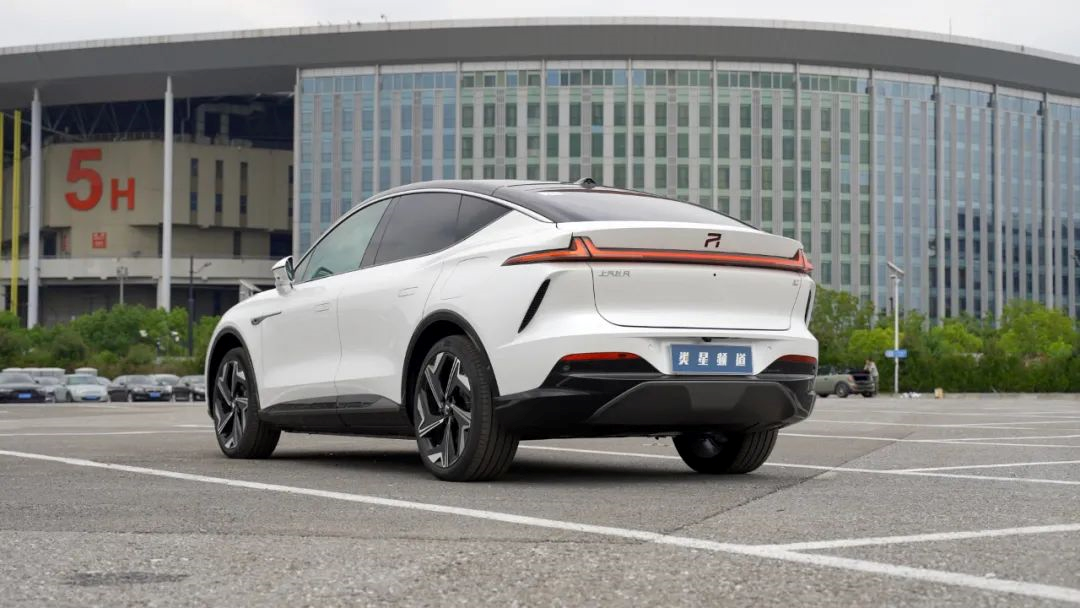
FeiVan R7 adopts a new design style with “simple but extraordinary” as its design concept. Its chief designer is none other than Martin Kropp. Don’t know him? That’s okay. If you’ve heard about the Volkswagen CC, then you surely know him. The first generation Volkswagen CC was hailed as “Volkswagen’s most beautiful model” at the time and was designed by Martin Kropp himself.# Flyin R7
With a large amount of streamlined design and a sleek body shape, Flyin R7 possesses a minimalist style without losing aesthetics. As a mid-to-large size SUV, the aerodynamic coefficient of the R7 is only 0.238, and its body size is 4900mm * 1925mm * 1655mm, with a wheelbase of 2950mm. Recently, Lesports Channel also conducted a size comparison of several popular mid-to-large-sized pure electric SUV models.
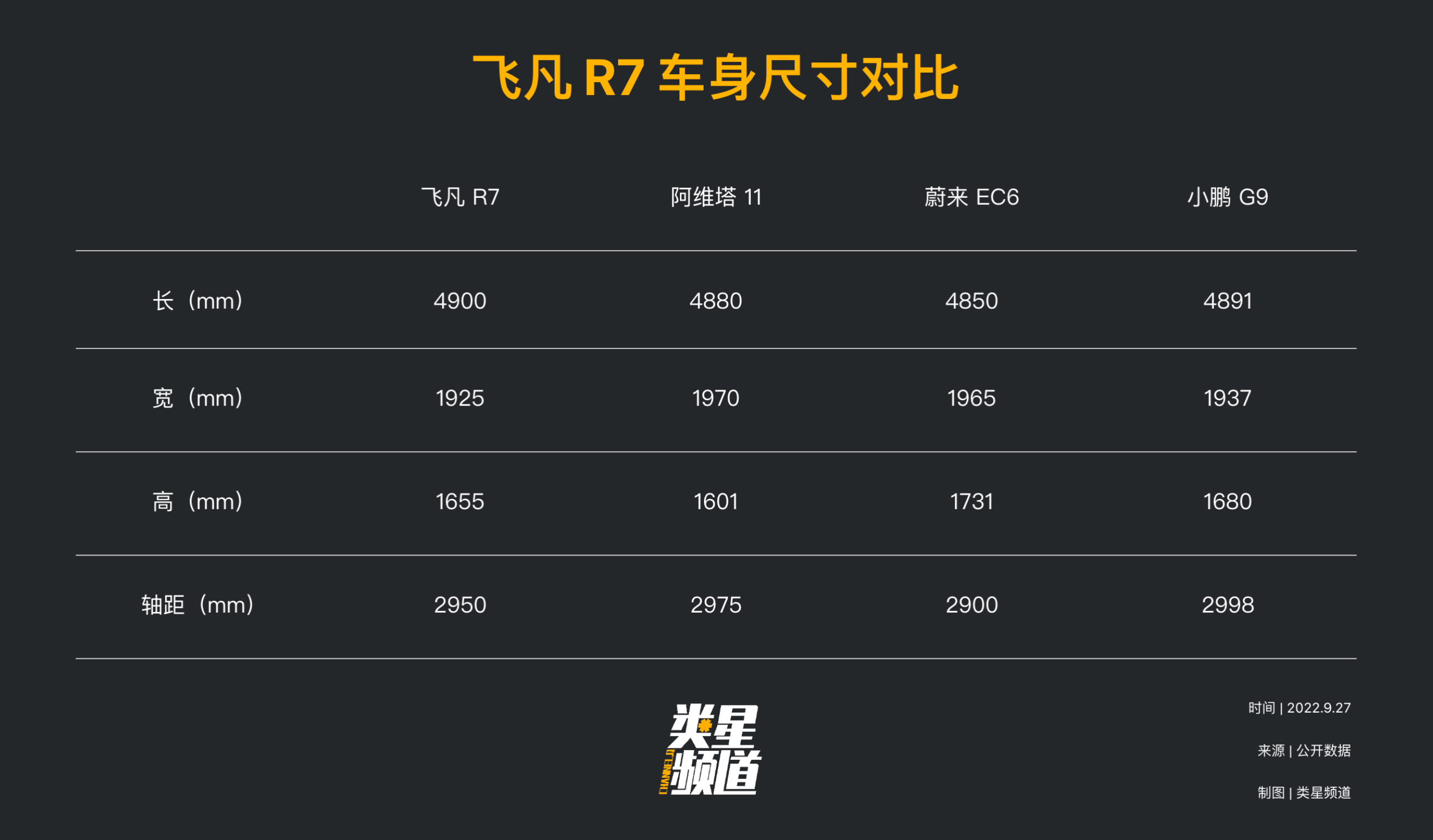
After reading, did you notice that the size of the R7 body is not large, making it easy to navigate through the city with ease? At the same time, the 2950mm wheelbase provides “hardcore protection” for the rear space. As a car model with a sleek shape, the headroom in the rear is my biggest concern. However, according to Lesports Channel’s actual experience, the headroom in the rear performs very well.
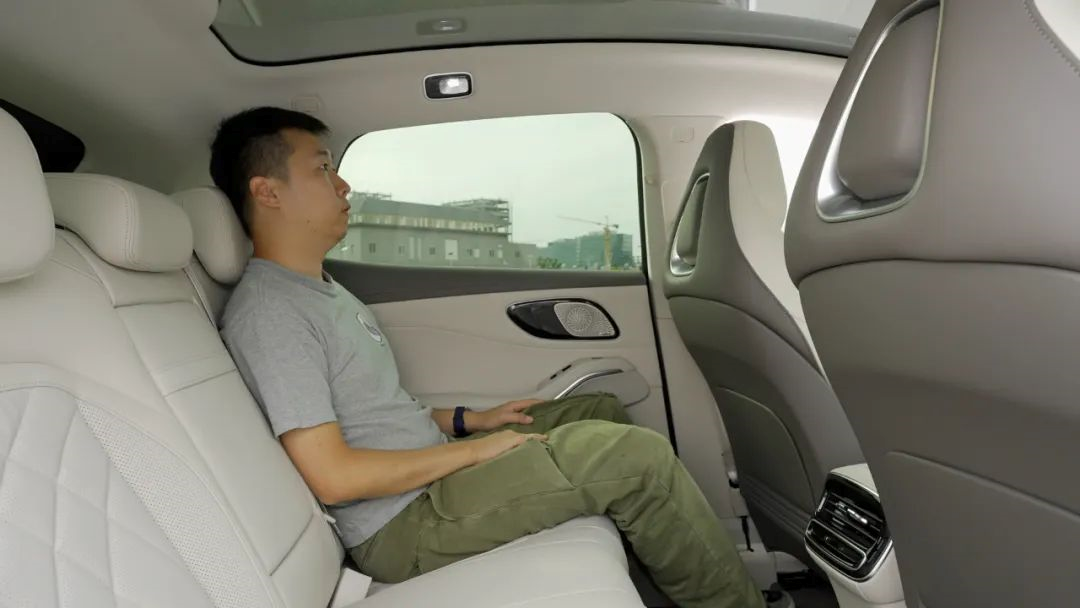
Once you step inside the car, you will be shocked by the overwhelming power of the 43-inch three-in-one screen.
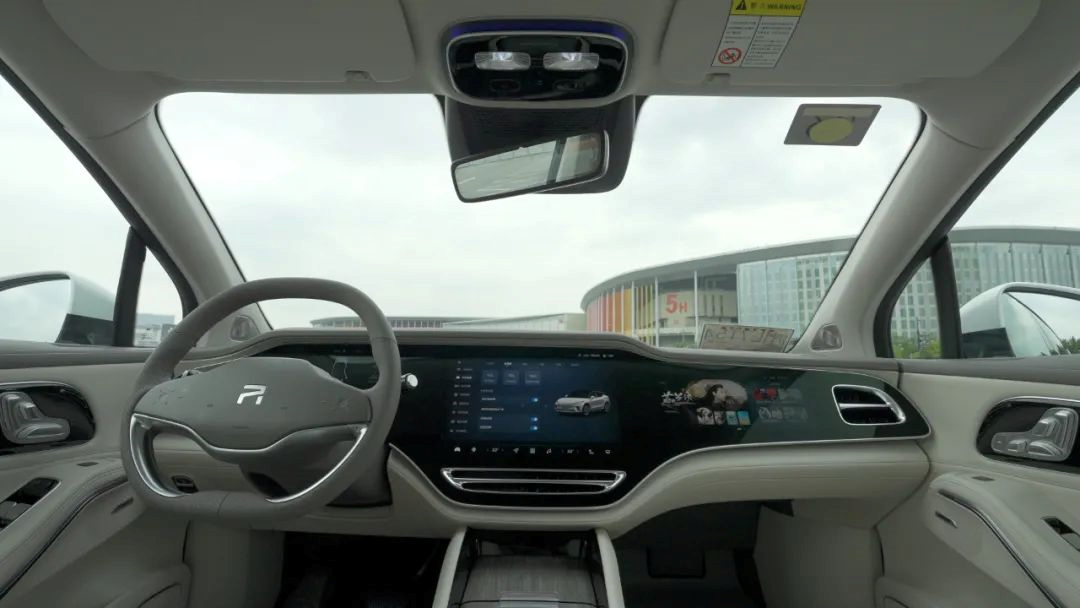
Moreover, the quality of this three-in-one screen cannot be overlooked, as it boasts:
-
An integrated glass panel enclosure
-
A 15.05-inch center console screen that uses JD’s AMOLED flexible screen, which is the same as the one in the NIO ET7
-
A 10.25-inch instrument panel and a 12.3-inch co-pilot screen that utilize MiniLED screens
If you have been paying attention to consumer electronics for a long time, you may be accustomed to AMOLED and MiniLED already. However, in terms of car-level hardware, AMOLED has only just begun to emerge this year. Compared to regular LCD screens, MiniLED has higher brightness, making the content on the instrument panel and co-pilot screen clearer under strong light.
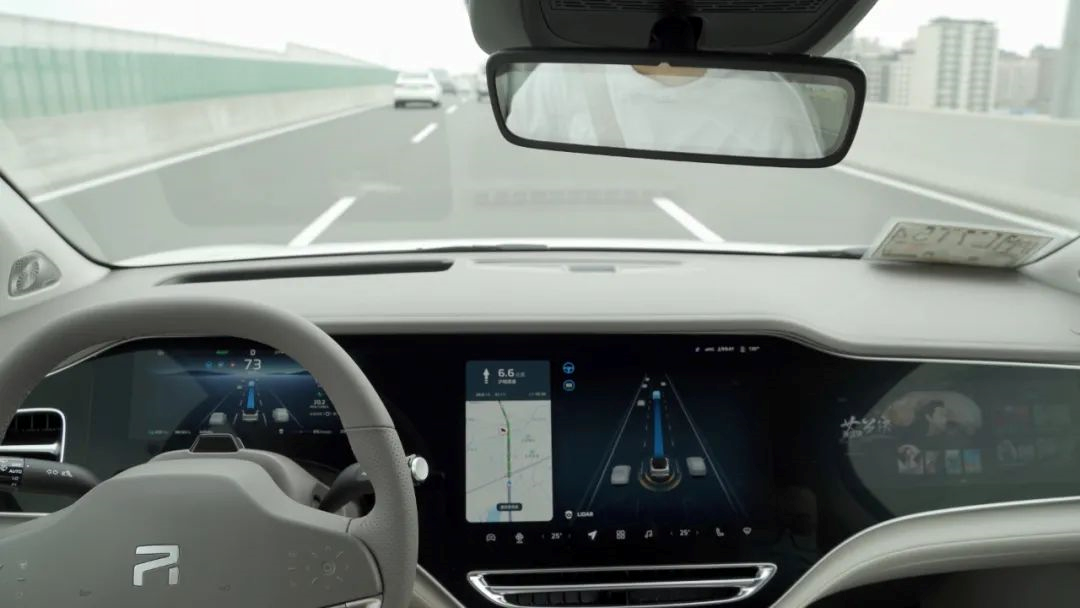 The central control of R7 adopts an AMOLED flexible screen, with a pixel density of 200 PPI and a refresh rate of 60 Hz, which means it has a more delicate display effect and smoother performance in this era of increasingly rich entertainment in-cars.
The central control of R7 adopts an AMOLED flexible screen, with a pixel density of 200 PPI and a refresh rate of 60 Hz, which means it has a more delicate display effect and smoother performance in this era of increasingly rich entertainment in-cars.
In addition to the high-quality three-screen, the R7 is equipped with the AR-HUD system that was first produced by Huawei.
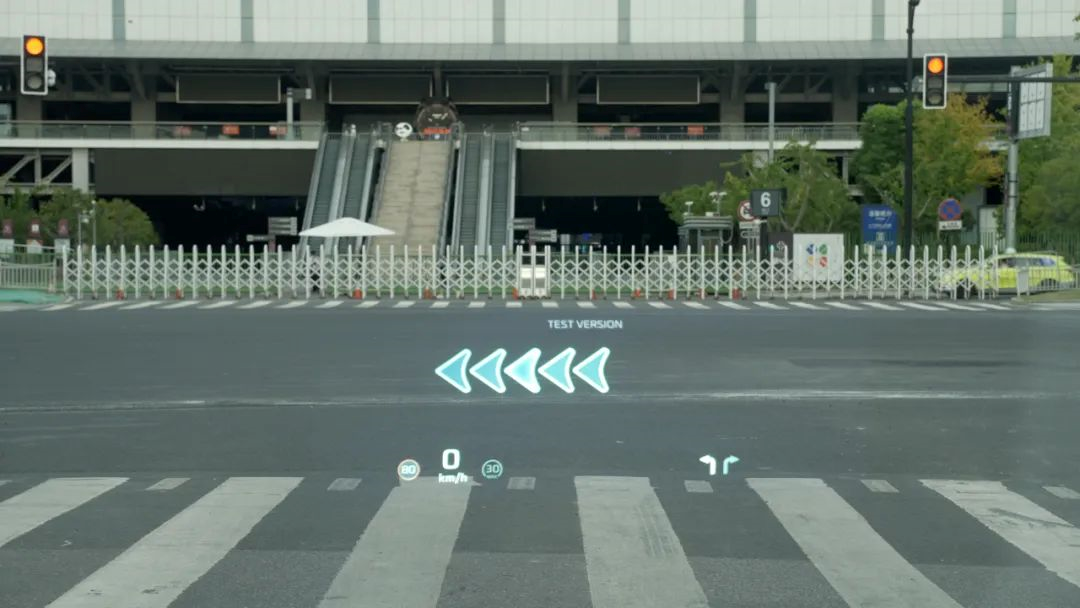
The hardware quality of this AR-HUD cannot be ignored:
-
The largest visible angle of any mass-produced vehicle in the world is 13°*5°
-
Resolution 1920*730
-
Maximum brightness up to 12000 nits
-
Contrast ratio of 1200:1
To sum up the hardware quality of this Huawei AR-HUD in one sentence, it has a large field of view, rich content, and clear display.
However, hardware is only the foundation, and it must have an excellent user experience to make the most of its power.
In the past, there were fewer and fewer physical buttons in cars, and more and more screens. Compared with the direct design of physical buttons, modern cabin design has been simplified a lot. However, problems have arisen, and users are increasingly complaining that car infotainment systems are not easy to use or convenient. In response to these issues, the R7 has made great efforts to improve the in-cabin experience.

When you first see the R7’s infotainment system UI, you can feel the simplicity and high-tech sensation. If you look patiently, the UI’s warm and cool color tones will automatically change over time, while the icon design is simple, clear, and unambiguous. Taking the UI design of the instrument cluster as an example, the background colors are rich enough to provide a good sense of space and texture, while the layout and display of information on vehicle speed, time, battery life, multimedia, and driver assist features are clear and well-organized enough to keep the driver’s visual focus on the road.

Entering the vehicle settings, the combination of the 3D model and the car control interface allows users to set the vehicle more intuitively and understand more easily. In addition, the voice assistant supports functions such as visible speech, continuous conversation, and multi-tonal regions, and even recognizes the unique dialects of Shanghai, further enhancing the user experience of the voice assistant. It is clear that R7 is not a brand from a traditional automaker and clearly knows what consumers want and like.
Reducing menu hierarchy and direct interaction are the top priorities in RisingAuto RISING OS. Swipe right with two fingers to pull out the floating window. The function bar card can customize frequently used functions, and swipe left with two fingers to hide the floating window and enter the map or video state. Even in the center console screen and co-pilot screen, you can pull down from the top of the screen to bring up the quick command interface. The car control and system logic are very clear, minimizing the learning cost for users.

The minimalist and direct operation experience of RISING OS, combined with the 8155 chip, makes the RisingAuto R7’s auto experience smooth, direct, and convenient. At the same time, RisingAuto R7 has a leading hardware foundation in the cabin, and will continue to iterate in software and interaction, gradually prospering RisingAuto’s own cabin ecology and interaction experience in the future.
Another major focus of intelligence is naturally intelligent driving, and excellent hardware foundation is the cornerstone, just like the cabin.
The RisingAuto R7 is equipped with 33 perception hardware devices, among which the most noteworthy is the Premium 4D imaging radar, which was first launched in China. What is a 4D imaging radar? Let’s explain it.
**You can think of it as an upgraded version of traditional millimeter-wave radar. The 4D imaging radar can provide four indicators of distance, angle direction, vertical height, and speed, and the point cloud density is improved, which can be imaged. Do you notice anything? It can measure vertical height and image, which is very important for intelligent driving. The following picture clearly shows the difference between traditional millimeter-wave and 4D imaging radars.
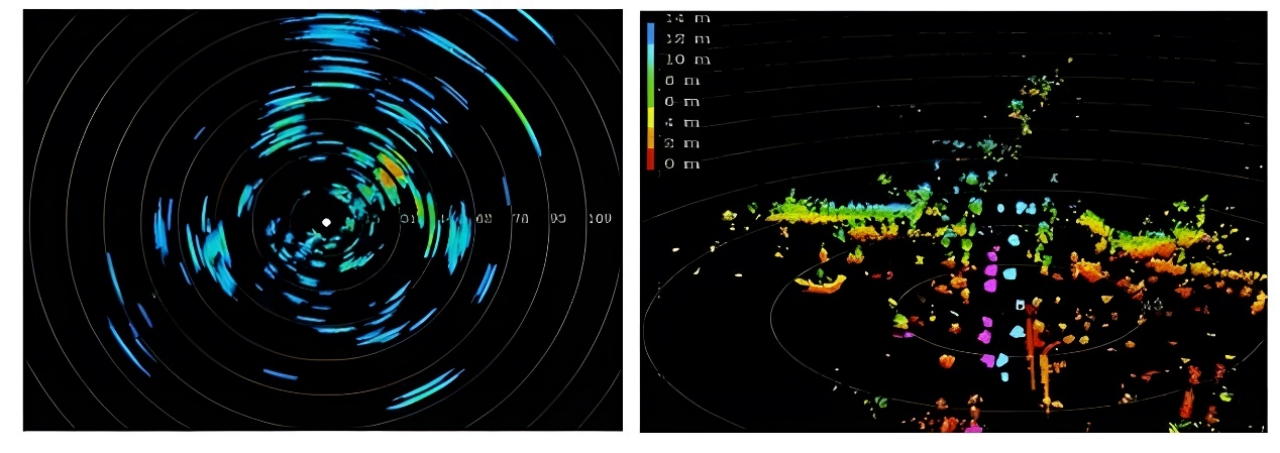 Traditional millimeter wave radar cannot measure height, so in many cases, in order to reduce the false alarm rate of millimeter wave radar, selective “ignore millimeter wave radar” data will be used. However, 4D imaging radar can detect the vertical height of an object and perform imaging, which means that it is possible to identify whether the object ahead is a manhole cover (can be run over) or a stone pillar (cannot be run over), providing a perception basis for subsequent algorithms. And the radar itself is not affected by strong light and bad weather, which can supplement the disadvantages of visual perception from another perspective. At the same time, 4D imaging radar also has a certain recognition ability for stationary objects, enhancing the safety of intelligent driving process.
Traditional millimeter wave radar cannot measure height, so in many cases, in order to reduce the false alarm rate of millimeter wave radar, selective “ignore millimeter wave radar” data will be used. However, 4D imaging radar can detect the vertical height of an object and perform imaging, which means that it is possible to identify whether the object ahead is a manhole cover (can be run over) or a stone pillar (cannot be run over), providing a perception basis for subsequent algorithms. And the radar itself is not affected by strong light and bad weather, which can supplement the disadvantages of visual perception from another perspective. At the same time, 4D imaging radar also has a certain recognition ability for stationary objects, enhancing the safety of intelligent driving process.
Of course, all hardware is only the foundation, and without excellent software engineering capabilities, it is all talk.

RisingAuto Auto has independently researched and developed the industry’s first FULL FUSION fusion algorithm, which combines three fusion algorithms: frontal fusion, rear fusion, and hybrid fusion. Simply put, at present, most automakers use the rear fusion algorithm, which means that different sensors will output different perception results, and the comprehensive perception results will be used to make decisions. The frontal fusion, on the other hand, performs real-time fusion of sensor perception results, which is what Tesla uses.
So what about full fusion? It synchronously integrates the front and rear fusion processes, and integrates high-precision map information and environmental information in the navigation function to achieve accurate judgment of the vehicle’s surrounding environment information, thereby achieving higher accuracy and efficiency in perception capability. The full fusion algorithm is also the latest achievement of RisingAuto’s more-than-500-person smart driving team, which has been self-developed for more than two years.

In addition to perception capabilities and excellent hardware attributes, RisingAuto has also launched the self-adjustable MY PILOT function, which allows users to choose from multiple intelligent driving styles, such as comfortable, standard, and sporty. For example, in the urban expressway scenario, you can choose the comfortable style to reduce lane-changing behavior and improve comfort. In the clear sky high-speed scenario, you can choose the sport mode to improve traffic efficiency.
In addition, in terms of driver fatigue monitoring, RisingAuto R7 uses a capacitive steering wheel, which means that during long-distance trips, you can simply place your hand on the steering wheel and do not need to press a button or shake the steering wheel every certain period of time, improving the convenience experience brought by intelligent driving.# Flyven R7: An Innovative Solution in the Field of Intelligent Driving
Flyven R7 blends SAIC’s expertise and Flyven’s unique features and introduces a refreshing smart driving system. According to Flyven, the system can be “used as soon as it is delivered,” and the company endeavors to define its next-generation product from the user’s perspective without any exaggeration.
At the same time, the renewable energy system, which can be charged, swapped, and upgraded, represents one of Flyven’s ways of empathizing with users.
A New Player in the Battery-Swapping Ecosystem
As mentioned at the beginning of this article, the experience of recharging with alternative energy still remains one of the most concerning problems for electric vehicle owners. Until now, NIO was the only player that deepened its roots in the battery-swapping field. This time, Flyven, in partnership with SAIC, introduces a fresh perspective on battery swapping. So, how does Flyven define battery swapping, being a pioneer in this field?
First, the system provides direct benefits to the customers. With Flyven R7, a customer can enjoy a direct national subsidy of 12,600 yuan after swapping. Of course, this subsidy will be suspended beginning next year, so customers should hurry up.
Second, the system has self-improvement benefits. Efficiency is one of the most critical advantages of battery swapping, among many other aspects. With batteries optimized by technology, Flyven provides the customers with the liberty to choose whether to use a small or large battery, enabling them to reduce the cost of daily commutes while satisfying long-distance travel needs.
At present, Flyven offers two types of batteries: 77 kW and 90 kW. As battery technology continually evolves, Flyven will undoubtedly introduce larger batteries to meet the growing needs of customers. However, one of the biggest advantages of battery swapping is often overlooked by most people: battery safety. The flyven battery swapping system can detect battery decay, battery maintenance issues, and alert customers of potential safety hazards. When you swap batteries at a designated station, you can almost be sure that the battery is safe for use.
Finally, there is the issue of battery-swapping station layout, which is of great concern to customers. Flyven’s solution may put your mind at ease. Flyven will collaborate with Shanghai Jieneng Zhidian to promote the development of a user-oriented battery-swapping ecosystem. The joint venture is founded by PetroChina, Sinopec, SAIC, Ningde Times, and others. It will transform over 50,000 fueling stations operated by PetroChina and Sinopec into an integrated charging and battery-swapping network.
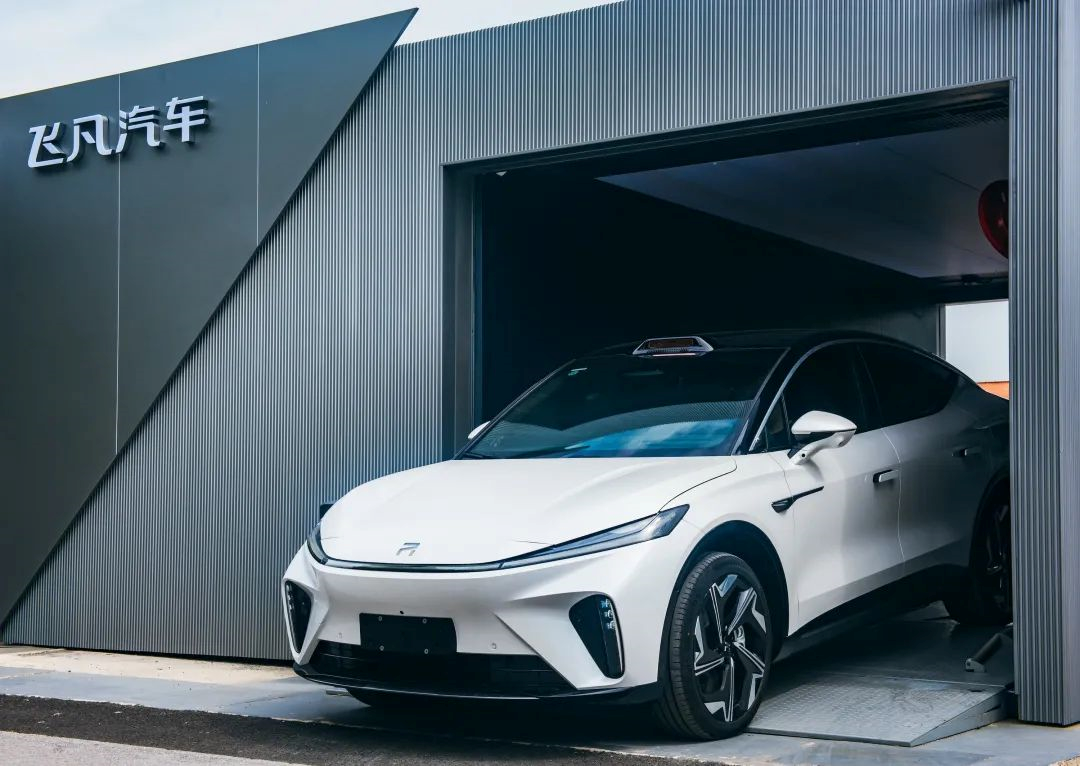 According to the report, this year, 40 comprehensive service energy stations will be built, with the number reaching 300 in 2023 and exceeding 3,000 in 2025. Feiteng R7 will be the first model to support gas station battery swapping. With the gradual popularity of battery swapping, Feiteng R7’s future long-distance travel will soon become a reality.
According to the report, this year, 40 comprehensive service energy stations will be built, with the number reaching 300 in 2023 and exceeding 3,000 in 2025. Feiteng R7 will be the first model to support gas station battery swapping. With the gradual popularity of battery swapping, Feiteng R7’s future long-distance travel will soon become a reality.
In summary, as a new player in battery swapping, Feiteng aims to provide users with a more accessible car purchase, more convenient and flexible energy supplement experience, and a more user-friendly philosophy to enhance the overall driving experience. Of course, a large number of comprehensive energy facilities will also benefit the entire new energy industry, and each enterprise that builds its own energy supplement system deserves praise.
“A cool place under the big trees”
Talking about Feiteng, we cannot avoid mentioning SAIC Group.
In fact, we often overlook the reserves of new energy technology in domestic giants like SAIC. However, the complex internal organizational structure of these giants makes it difficult for each one to transition to new energy.
Instead, since its independence in November 2021, Feiteng has swiftly pushed its products to market by integrating SAIC’s accumulated resources and technology.
Under the protection of the SAIC giant tree, Feiteng has access to better hardware resources than other brands, as demonstrated by its use of Continental’s 4D imaging radar, a domestic debut. SAIC’s accumulated supply chain relationship cannot be ignored.
While obtaining technology and resources, Feiteng can operate independently of SAIC. It is closer to users and feedback is faster due to the absence of organizational constraints. Therefore, even if you remove the Feiteng R7 logo, you might think it’s a new car from a new name-brand, and it also possesses SAIC’s accumulated car-making experience and technology.
Feiteng R7 integrates all the best features from hardware to software, and this is a full validation of SAIC’s new energy technology accumulated over the years.
As Feiteng CEO Wu Bing said, “China’s new energy market is still at the stage of defining products and brands.” The product power of Feiteng R7 is beyond doubt, and the brand’s recognition and price are what consumers are also concerned about.
Introducing a battery swapping system can quickly lower the entry price of Feiteng R7 and bring it closer to more consumers. Although Feiteng’s single-car gross margin may not be too high, it is crucial for Feiteng to let more consumers experience, understand and establish a strong product brand image.We are also looking forward to the arrival of the RisingAuto R7, which will enable the RisingAuto brand to make a leap forward.
END
This article is a translation by ChatGPT of a Chinese report from 42HOW. If you have any questions about it, please email bd@42how.com.
